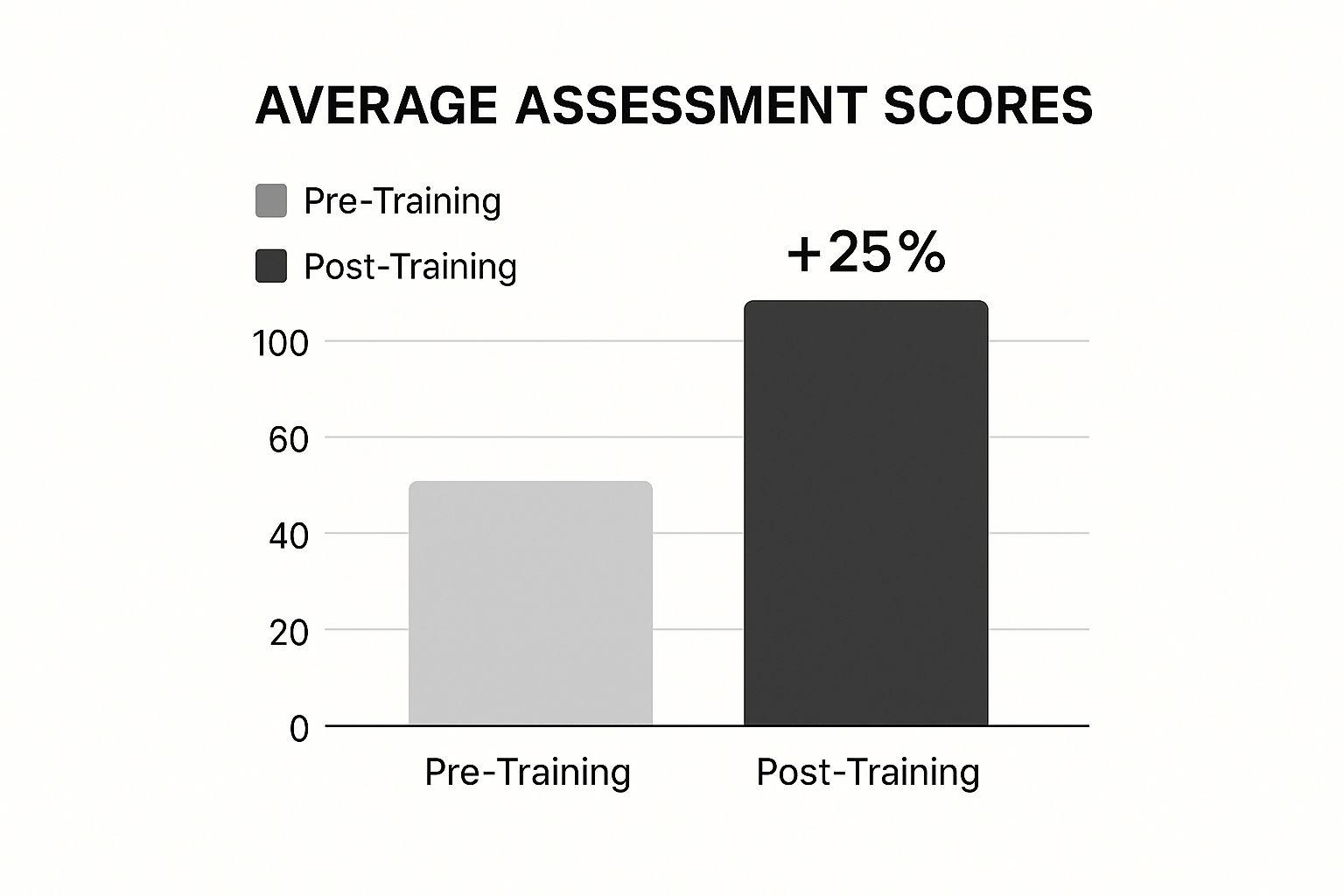The Training Impact Crisis: Why Most Programs Fall Short

Organizations today are facing a crucial challenge: making the most of their training investments. Companies dedicate significant resources to developing their employees, but many programs fail to deliver meaningful results. This gap between learning and tangible business outcomes creates a training impact crisis.
High satisfaction scores and impressive completion rates can give a false sense of achievement, hiding underlying problems with how effective the training really is. This often results in a cycle of investment without a corresponding return, which can hold back both organizational growth and employee development.
The Illusion of Success: Why Traditional Metrics Fail
Traditional training evaluations, like reaction surveys and completion rates, often focus on the activity of learning, not its impact. Employees might enjoy a training session and finish all the required modules, but that doesn't mean they're using what they learned on the job.
These traditional metrics don't capture the true value of training, such as improved performance, increased productivity, or other key business outcomes. This can create a misleading sense of success, where organizations think their training programs are working well when, in reality, they aren't providing a good return on investment.
U.S. businesses spend over $100 billion every year on employee training. Yet, a significant portion doesn't deliver a worthwhile ROI. Reports show that organizations lose $13.5 million per 1,000 employees annually due to ineffective programs (as of 2025 data). Many initiatives suffer from poor knowledge retention and minimal performance impact. This highlights the need for structured evaluation models like Kirkpatrick's Four-level Framework. You can find further statistics here: Learn more about measuring training effectiveness. This framework emphasizes measuring not just reaction and learning, but behavior change and business results as well.
Shifting to Outcome-Based Measurement
To address the training impact crisis, leading organizations are shifting their focus from activity-based metrics to outcome-based measurement. How we measure training effectiveness now centers on showing real improvements in key areas:
- Employee Performance: Are employees doing their jobs more efficiently and effectively after training?
- Business Outcomes: Has the training resulted in increased sales, lower costs, or higher customer satisfaction?
- Behavioral Change: Are employees actually using their new skills and knowledge on the job and demonstrating different behaviors?
This fundamental shift requires a smarter evaluation strategy. It's about more than just asking participants if they liked the training. Consider calculating the ROI of security awareness training to grasp the full value of your training efforts.
By connecting training evaluation with strategic business objectives, organizations can finally prove the true value of their learning investments. This empowers L&D leaders to make informed decisions based on data, optimize training programs, and ensure that every dollar spent on development contributes to meaningful organizational growth. This outcome-focused approach will be essential for navigating the future of employee training and development.
Mastering the Kirkpatrick Model: Beyond Basic Evaluation

The Kirkpatrick Model is a powerful framework for evaluating training effectiveness. It provides a structured approach to measuring the true impact of your learning programs. But simply checking off each level isn't enough. True mastery lies in understanding how to adapt and apply the model within your unique learning environment. It's about using the model as a dynamic tool for continuous improvement, pushing beyond basic evaluation to achieve truly impactful results.
Breathing New Life into a Classic Framework
Introduced in the 1950s, the Kirkpatrick Model remains a cornerstone for measuring training effectiveness worldwide. Its enduring relevance speaks volumes about its power in the ever-changing world of Learning and Development (L&D). But avoid treating it as a static checklist. Approach each level with fresh eyes, tailoring your methods to the specific training program. For example, instead of generic reaction surveys, craft feedback mechanisms that explore the why behind participant responses. This yields actionable insights for future program improvements. Discover more powerful insights on measuring training effectiveness. Studies show organizations using this framework see a 15-20% improvement in tracking behavioral changes (Level 3) and business impact (Level 4).
Adapting the Kirkpatrick Levels for Modern Learning
-
Level 1 (Reaction): This goes beyond simply measuring satisfaction. Modern reaction evaluations should predict future application by exploring participant confidence, perceived relevance, and how they intend to use their new knowledge.
-
Level 2 (Learning): Don't just check for basic knowledge. Focus on assessing the acquisition of real-world skills through simulations, performance-based assessments, and practical application exercises.
-
Level 3 (Behavior): The key here is to implement behavior tracking systems that don't overwhelm managers. Leverage technology, peer feedback, and self-reflection tools to gather data on how learned skills are being applied on the job.
-
Level 4 (Results): Connecting learning to tangible business outcomes is crucial. Demonstrate the training's impact on metrics that resonate with executives, such as increased sales, improved customer satisfaction, or reduced costs.
Visualizing Kirkpatrick Model Effectiveness
The following data chart illustrates the potential impact of actively applying the Kirkpatrick Model across its four levels. It visualizes potential improvements in key performance areas achieved through effective use of the model.
- Level 1 (Reaction): 80% Positive Reaction Rate
- Level 2 (Learning): 70% Knowledge and Skill Improvement
- Level 3 (Behavior): 60% On-the-Job Application Increase
- Level 4 (Results): 50% Improvement in Key Business Metrics
As the chart demonstrates, a focused approach to each level of the Kirkpatrick Model correlates with a significant lift in positive training outcomes. While the most substantial gains are often seen in initial reaction and learning, the most valuable changes – behavior change and business results – also see noticeable improvement. This underscores the power of committing to all four levels. Addressing potential pitfalls early in the implementation process is essential for effective measurement. This proactive approach ensures the collection of meaningful data that truly reflects the return on your training investments. By strategically implementing each level and addressing potential roadblocks, you can unlock the full potential of the Kirkpatrick Model and drive significant business results through powerful and effective training.
To further illustrate the Kirkpatrick Model, let's examine a breakdown of each level:
Kirkpatrick's Four Levels of Training Evaluation
| Level | Focus | Evaluation Methods | Timing | Key Metrics |
|---|---|---|---|---|
| 1. Reaction | Participant satisfaction and engagement | Surveys, feedback forms, post-training questionnaires | Immediately after training | Satisfaction scores, engagement levels, participant feedback |
| 2. Learning | Knowledge and skill acquisition | Tests, quizzes, assessments, observations | During and after training | Test scores, skill demonstration, knowledge retention |
| 3. Behavior | On-the-job application of learned skills | Observations, performance reviews, 360-degree feedback, self-assessments | Weeks or months after training | Change in behavior, frequency of skill use, performance improvement |
| 4. Results | Business impact and ROI | Performance data, business metrics, cost analysis | Months or years after training | Increased sales, improved productivity, reduced costs, ROI |
This table provides a comprehensive overview of the Kirkpatrick Model, outlining the focus, evaluation methods, timing, and key metrics for each level. By understanding these elements, organizations can effectively measure the impact of their training programs and ensure that learning translates into tangible business results.
The Multi-Method Measurement Approach That Actually Works

Want to truly understand the effectiveness of your training programs? It's time to move beyond simple metrics. Relying solely on participant satisfaction or completion rates won't give you the full picture. To unlock the real potential of your training, embrace a multi-method measurement system. This approach gathers data from various sources to reveal the true influence of your programs on individuals and the business as a whole.
Combining Qualitative and Quantitative Data
The power of multi-method measurement lies in its balanced approach. It strategically blends qualitative and quantitative data to create a comprehensive narrative. Quantitative metrics, like assessment scores, performance data, and business outcomes offer concrete evidence of your training's impact. Think increased sales figures or improved productivity numbers – these are the tangible results you're looking for.
But numbers alone don't tell the whole story. Qualitative elements, such as participant stories from interviews, manager observations, and focus group insights, provide crucial context. They add depth and meaning to the numbers, revealing the "why" behind the "what." For instance, a rise in sales post-training might be linked to improved communication skills, as revealed by qualitative feedback. These insights are invaluable for refining your training strategy.
Designing Complementary Measurement Tools
Multi-method measurement is about creating a system where each data point contributes to a holistic view. The goal isn't to use isolated metrics but rather to design tools that complement each other. This means carefully selecting evaluation methods that work together to paint a complete picture.
Consider pre- and post-training assessments. These can quantitatively measure knowledge gain. Pair these with follow-up interviews to qualitatively explore how that knowledge is being applied on the job. This combined approach provides a richer, more nuanced understanding than either method alone.
A 2023 analysis revealed a striking difference in training outcomes. Companies combining multiple evaluation methods – surveys, Learning Management System (LMS) analytics, and performance metrics – achieved 25% better training outcomes than those relying on single measures. Furthermore, firms using real-time LMS data to track course completion and quiz scores reported 40% higher learner engagement. Want to dive deeper into these findings? Discover more insights about measuring training effectiveness. This data reinforces the power of a multifaceted approach.
Tailoring Evaluation to Learning Contexts
One size doesn't fit all when it comes to training evaluation. Different learning contexts require different approaches. A program focused on technical skills might prioritize quantitative assessments and performance metrics. However, leadership development training might benefit more from qualitative feedback through 360-degree reviews and observational data.
Recognizing these nuances allows you to tailor your evaluation strategies. Align your chosen methods with the specific goals and objectives of each program. This targeted approach ensures you're collecting the most relevant data. Ultimately, a multi-method measurement approach unveils insights that traditional evaluations miss. This deeper understanding empowers L&D professionals to optimize training programs, demonstrate ROI, and contribute significantly to organizational success.
Leveraging Technology: The New Frontier of Training Analytics
The learning landscape we have today gives us incredible opportunities to understand how effective our training programs really are. This is amplified when organizations use technology to gather and analyze data. From Learning Management Systems (LMS) like Moodle to learning experience platforms such as Degreed and specialized analytics tools, technology offers a new level of insight into what's working and what needs improvement. Effective training relies heavily on leveraging the right technologies. You can even explore specialized training programs like social engineering training to enhance your overall security posture.
Moving Beyond Basic Metrics
Traditional metrics like course completion rates only scratch the surface. They don't provide the depth of information needed for truly meaningful analysis. Instead of simply tracking course completion, we can now explore engagement patterns.
This allows us to see how learners interact with the content. Are they actively participating in discussions? Are they revisiting specific modules? These patterns give us valuable clues about knowledge absorption and identify areas where learners might be struggling.
Technology also allows us to follow skill development trajectories. We can assess not just immediate knowledge gain, but also long-term skill application and measure whether training translates into real-world performance improvements. Imagine tracking how a sales training program influences sales conversions over several months – the potential insights are invaluable.
Integrating Learning Data with Performance Systems
One of the most powerful benefits of technology is the ability to integrate learning data with performance systems. This creates a clear connection between development activities and business outcomes. By linking training data with performance metrics, we can finally answer the crucial question: Is our training making a difference to the bottom line?
Imagine connecting a customer service training program to customer satisfaction scores. This direct link helps demonstrate the real value of the training investment. This integration enables organizations to pinpoint which training programs are generating the highest ROI and prioritize future investments accordingly. It shifts L&D from a cost center to a strategic driver of business success, empowering truly data-driven decisions.
Identifying Meaningful Metrics
Not all metrics are created equal. Some provide valuable insights, while others can paint a misleading picture of progress. Technology helps us differentiate between the two. For example, high engagement rates might seem positive, but if they aren't correlated with improved performance, they might point to a problem with the training content itself. The key is to find the metrics that truly matter.
Choosing the Right Technology
Choosing the right technology is a critical step in successful training measurement. The table below outlines key considerations when evaluating different options.
To help you in this process, take a look at the following comparison:
Training Evaluation Technologies Comparison: A comparison of different technological solutions for measuring training effectiveness, including their features, benefits, and ideal use cases.
| Technology | Key Features | Metrics Tracked | Best For | Implementation Complexity |
|---|---|---|---|---|
| LMS | Course delivery, tracking completion, basic assessments | Completion rates, quiz scores, time spent on modules | Tracking basic learning activities | Low |
| Learning Experience Platform (LXP) | Personalized learning paths, content curation, social learning features | Engagement rates, content consumption, community activity | Fostering learner engagement | Medium |
| Specialized Analytics Tools | Advanced data analysis, predictive modeling, performance dashboards | Skill development trajectories, correlation between learning and business outcomes | Measuring training ROI | High |
This table summarizes the strengths and weaknesses of each technology, enabling a more informed decision-making process. By understanding the different features and capabilities, you can choose the best fit for your organization's unique needs and maximize your ability to measure training effectiveness. This strategic approach helps ensure that you're not just collecting data, but using it to drive real improvements in your training programs and, ultimately, your organization's success.
Measuring What Matters: Tracking Behavioral Change

Training programs often focus on knowledge acquisition. But true success lies in seeing how that knowledge transforms workplace behavior. This is the most demanding aspect of training evaluation. Let's explore practical ways to measure this crucial shift.
Establishing Meaningful Baselines
Measuring change requires a starting point. Establishing a baseline means measuring behaviors before training. This creates a benchmark for comparison with post-training performance.
For example, if training aims to elevate customer service, the baseline might be customer satisfaction scores or call resolution times. This sets the stage for quantifiable progress.
Designing Practical Observation Frameworks
Managers are key to observing behavioral change. But they need effective tools. Simple, easy-to-use observation frameworks are essential. These frameworks should target specific, observable behaviors tied to the training objectives.
Think checklists or rating scales to track communication, teamwork, or problem-solving. These tools empower managers to document growth and offer targeted feedback.
Implementing Effective Peer Feedback Systems
Peer feedback offers invaluable perspective. Structured peer feedback systems make this process constructive. Consider anonymous feedback tools or guided discussions.
This approach can reveal blind spots and foster continuous improvement. Remember, focus feedback on specific behaviors, not personality traits, for maximum impact.
Creating Accountability Structures
Lasting change requires accountability. Build structures that reinforce the application of new skills. Regular manager check-ins, peer coaching, or integrating new behaviors into performance reviews are all effective strategies.
Weaving desired behaviors into daily work creates a system where consistent application is the standard. This reinforces learning and fosters lasting change.
Differentiating Between Compliance and Genuine Change
Temporary compliance isn't true behavioral change. Compliance fades when oversight ends. Genuine change integrates into an individual’s work habits.
This takes ongoing support, reinforcement, and integration into company culture. The Global Human Resource Institute (GHRI) provides advanced certification programs focused on fostering lasting change. Explore GHRI’s HR certifications to empower your HR strategy.
By using these strategies, organizations can clearly see training's impact on behavior. This paves the way to connect learning with tangible results and maximize training ROI. Ultimately, this fuels better employee performance and drives organizational success.
From Learning Metrics to Business Impact: Proving Training ROI
Measuring the effectiveness of training programs goes beyond simply tracking completion rates or collecting feedback. True success lies in demonstrating a tangible return on investment (ROI). This means connecting learning initiatives to the metrics that truly matter to executives and stakeholders – the bottom line. This section offers a practical approach for linking training to demonstrable business results.
Identifying Key Business Indicators
The first step is identifying the Key Performance Indicators (KPIs) that truly reflect organizational success. These KPIs will vary depending on your industry and specific business goals. For a sales team, it might be revenue growth or increased conversion rates. For a customer service team, KPIs could include higher customer satisfaction scores or faster resolution times. The key is to choose metrics directly influenced by the training program.
Establishing Attribution Methodologies
Once you've identified your KPIs, it's essential to establish clear attribution methodologies. This means determining how much of a positive change in those KPIs can be reasonably attributed to the training. This can be a complex process, as many factors influence business performance. However, combining quantitative data analysis with qualitative feedback can help you build a compelling case for the training's contribution.
For example, if customer satisfaction scores improve after a customer service training program, analyze other potential contributing factors. Did product offerings or marketing campaigns change around the same time? By isolating the impact of the training, you can create a more defensible ROI calculation.
Calculating Defensible ROI Figures
Calculating training ROI involves comparing the financial benefits of the training to its overall costs. This requires detailed cost analysis, including development, delivery, and participant time. Quantify the training's impact on KPIs, such as increased sales, reduced errors, or improved productivity.
Expressing ROI as a ratio or percentage clearly communicates the financial return of the training investment. For example, an ROI of 2:1 signifies that for every dollar invested in training, the organization gained two dollars in return.
Presenting Compelling Evidence of Impact
Demonstrating ROI isn't just about numbers; it's about telling a compelling story. Use a combination of quantitative data and qualitative anecdotes to illustrate the training's positive impact. Share success stories of employees who applied their new skills to achieve significant results.
Showcase how training has helped the organization achieve its strategic goals. By presenting a clear and persuasive narrative, you can demonstrate the true value of training and secure continued investment in employee development.
Exploring Quantitative and Qualitative Approaches
While quantitative data is essential for demonstrating ROI, don't underestimate the power of qualitative insights. Gather feedback from participants, managers, and other stakeholders to capture the training program's full impact.
Conduct interviews, focus groups, and surveys to uncover how training has influenced employee behavior, morale, and overall organizational culture. These qualitative data points provide valuable context for your quantitative findings and further strengthen your ROI narrative.
Through a combination of robust data analysis and compelling storytelling, you can go beyond simply measuring learning metrics and demonstrate the real business impact of training investments. This empowers you to justify your L&D budget and advocate for continued support of employee development initiatives. Ready to elevate your HR strategy and demonstrate the true value of your training programs? Explore the advanced certification programs offered by the Global Human Resource Institute (https://www.globalhrinstitute.website). These programs provide the tools and frameworks needed to effectively measure training effectiveness, prove ROI, and establish L&D as a strategic driver of organizational success.




0 Comments